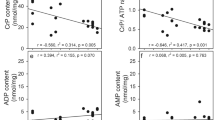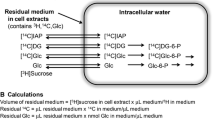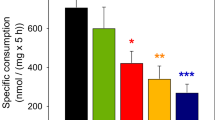Abstract
We have investigated effects of various energy substrates including glucose, lactate and pyruvate on the recovery of the high energy phosphate levels after high-K+ stimulation in rat brain slices by using 31P NMR. It was found that lactate, pyruvate and glucose almost equally supported the recovery of phosphocreatine (PCr) levels after high-K+ stimulation (60 mM, 8 min) in artificial cerebrospinal fluid (ACSF). In iodoacetic acid (IAA) and fluorocitrate (FC)-pretreated slices, whereas glucose was unable to be utilized, the recovery of the PCr level after high-K+ stimulation in ACSF containing lactate was completely abolished, the recovery of the PCr in ACSF containing pyruvate was unaffected. These results indicate that neurons themselves can utilize pyruvate as an exogenous energy substrate, but not lactate, without glial support. In intact brain, glucose may be metabolized to pyruvate in glial cells and then transported to neurons as an energy substrate. These suggest an astrocyte-neuron pyruvate shuttle mechanism of the brain energy metabolism in vivo.
We also investigated the effect of ischemic-preconditioning in FC-pretreated slices, which showed that the PCr levels recovered substantially in ACSF containing lactate after high-K+ stimulation. This indicates that after the preconditioning, such as ischemia, neurons themselves acquired the ability to utilize lactate as an energy substrate.
Similar content being viewed by others
References
Sokoloff L: Relation between physiological function and energy metabolism in the central nervous system. J Neurochem 29: 13-26, 1977
Mcllwain H, Bachelard HS: Metabolic, ionic and electrical phenomena in separated cerebral tissue. In: Biochemistry and the Central Nervous System, 5th edn. Livingstone, Edinburgh, 1985, pp 54-83
Magistretti PJ: Brain energy metabolism. In: M.J. Zimond et al. (eds). Fundamental Neuroscience. Academic Press, San Diego, 1999, pp 389-413
Yoshioka K, Nisimaru N, Yanai S, Shimoda H, Yamada K: Characteristics of monocarboxylates as energy substrates other than glucose in rat brain slices and the effect of selective glial poisoning—a 31P NMR study. Neurosci Res 36: 215-26, 2000
Schurr A, Dong WQ, Reid KH, West CA, Rigor BM: Lactic acidosis and recovery of neuronal function following cerebral hypoxia in vitro. Brain Res 438: 311-314, 1988
Schurr A, Payne RS, Miller JJ, Rigor BM: Glia are the main source of lactate utilized by neurons for recovery of function posthypoxia. Brain Res 774: 221-224, 1997
Cox DW, Bachelard HS: Attenuation of evoked field potentials from dentate granule cells by low glucose, pyruvate + malate, and sodium
Author information
Authors and Affiliations
Rights and permissions
About this article
Cite this article
Kitano, T., Nisimaru, N., Shibata, E. et al. Monocarboxylates and glucose utilization as energy substrates in rat brain slices under selective glial poisoning – a 31P NMR study. Mol Cell Biochem 244, 77–81 (2003). https://doi.org/10.1023/A:1022461118479
Issue Date:
DOI: https://doi.org/10.1023/A:1022461118479




